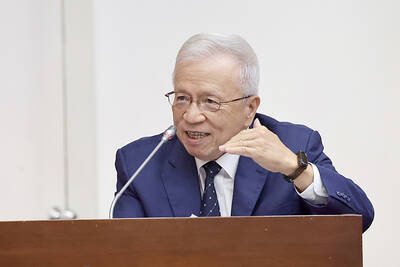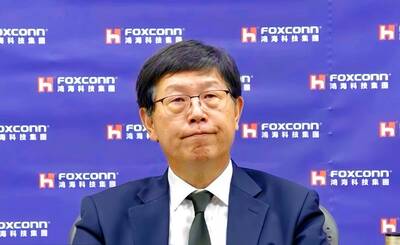A plan by the four major units of Formosa Plastics Group (FPG, 台塑集團) to lower their stakes in a steel mill in Vietnam reflects the group’s caution about global demand, analysts said yesterday.
“As China, one of the world’s largest steel buyers, will no longer pursue high economic growth, global steel demand could slow down accordingly,” Hua Nan Securities (華南永昌證券) analyst Henry Miao (苗台生) said.
In the second quarter, China’s economy grew 7.5 percent year-on-year, slowing from a 7.7 percent increase in the first quarter.
Beijing expects GDP this year to grow by 7.5 percent, compared with a 7.7 percent increase recorded last year. Chinese authorities have said the country wants a more balanced economy rather than simply seeking high GDP growth.
“I think FPG has taken possible lower demand from China into account and decided to cut its stake in the steel investment project in Vietnam,” Miao said.
The group’s four major units — Formosa Plastics Corp (台塑), Nan Ya Plastics Corp (南亞塑膠), Formosa Chemicals & Fibre Corp (台灣化纖) and Formosa Petrochemical Corp (台塑石化) — said on Thursday that they each decided to cut stakes in Formosa Ha Tinh Steel Corp (台塑河靜鋼鐵興業) to 14.75 percent from 21.25 percent.
Before the adjustments, the subsidiaries had poured US$744 million each into the
Vietnam steel project, which is still under construction. It is scheduled to become operational in the second half of 2015 with an annual production capacity of 7 million tonnes.
After the reductions, the four investments in the Vietnam project are expected to be worth US$516 million each.
The group said the four subsidiaries are expected to see their financial burdens eased due to the smaller investments. It added that because steel production is not their core business, they aim to introduce partners in the global steel industry to help them push the Vietnam project forward.
Media reports said FPG plan to introduce foreign partners such as Nippon Steel Corp to the project.

JITTERS: Nexperia has a 20 percent market share for chips powering simpler features such as window controls, and changing supply chains could take years European carmakers are looking into ways to scratch components made with parts from China, spooked by deepening geopolitical spats playing out through chipmaker Nexperia BV and Beijing’s export controls on rare earths. To protect operations from trade ructions, several automakers are pushing major suppliers to find permanent alternatives to Chinese semiconductors, people familiar with the matter said. The industry is considering broader changes to its supply chain to adapt to shifting geopolitics, Europe’s main suppliers lobby CLEPA head Matthias Zink said. “We had some indications already — questions like: ‘How can you supply me without this dependency on China?’” Zink, who also

At least US$50 million for the freedom of an Emirati sheikh: That is the king’s ransom paid two weeks ago to militants linked to al-Qaeda who are pushing to topple the Malian government and impose Islamic law. Alongside a crippling fuel blockade, the Group for the Support of Islam and Muslims (JNIM) has made kidnapping wealthy foreigners for a ransom a pillar of its strategy of “economic jihad.” Its goal: Oust the junta, which has struggled to contain Mali’s decade-long insurgency since taking power following back-to-back coups in 2020 and 2021, by scaring away investors and paralyzing the west African country’s economy.

BUST FEARS: While a KMT legislator asked if an AI bubble could affect Taiwan, the DGBAS minister said the sector appears on track to continue growing The local property market has cooled down moderately following a series of credit control measures designed to contain speculation, the central bank said yesterday, while remaining tight-lipped about potential rule relaxations. Lawmakers in a meeting of the legislature’s Finance Committee voiced concerns to central bank officials that the credit control measures have adversely affected the government’s tax income and small and medium-sized property developers, with limited positive effects. Housing prices have been climbing since 2016, even when the central bank imposed its first set of control measures in 2020, Chinese Nationalist Party (KMT) Legislator Lo Ting-wei (羅廷瑋) said. “Since the second half of

AI BOOST: Next year, the cloud and networking product business is expected to remain a key revenue pillar for the company, Hon Hai chairman Young Liu said Manufacturing giant Hon Hai Precision Industry Co (鴻海精密) yesterday posted its best third-quarter profit in the company’s history, backed by strong demand for artificial intelligence (AI) servers. Net profit expanded 17 percent annually to NT$57.67 billion (US$1.86 billion) from NT$44.36 billion, the company said. On a quarterly basis, net profit soared 30 percent from NT$44.36 billion, it said. Hon Hai, which is Apple Inc’s primary iPhone assembler and makes servers powered by Nvidia Corp’s AI accelerators, said earnings per share expanded to NT$4.15 from NT$3.55 a year earlier and NT$3.19 in the second quarter. Gross margin improved to 6.35 percent,